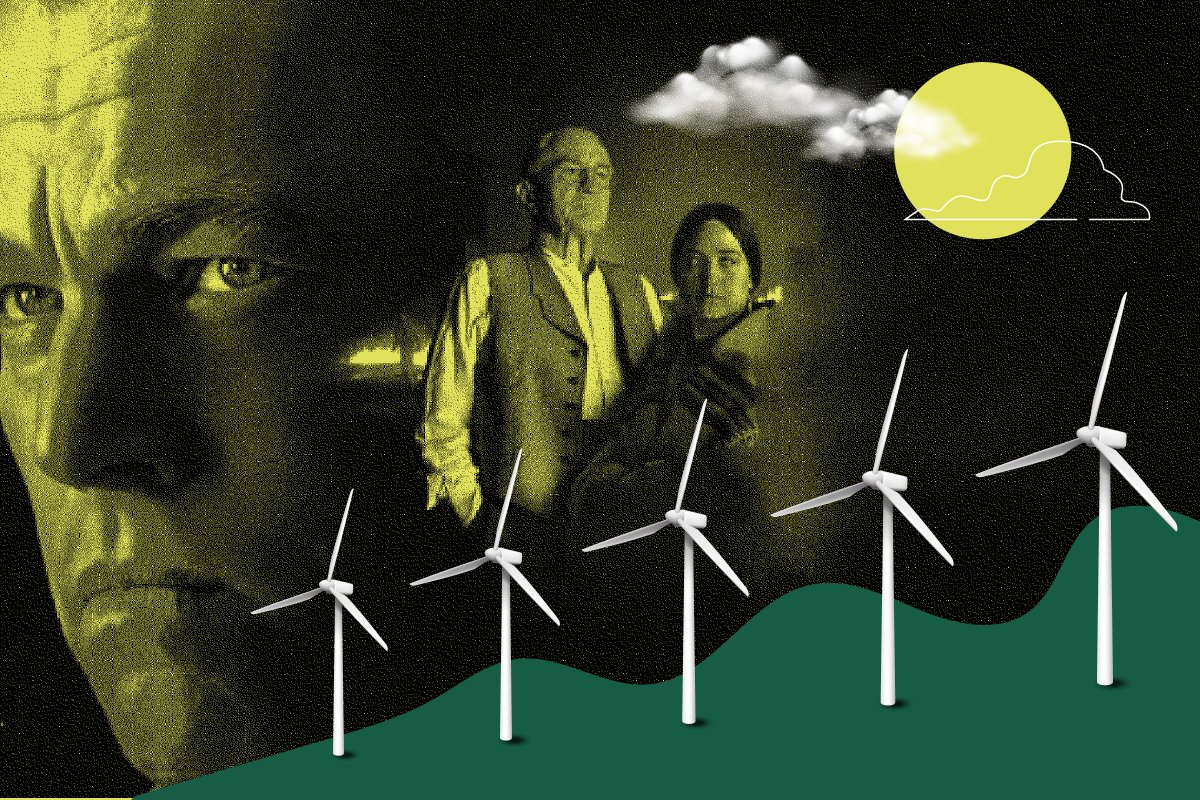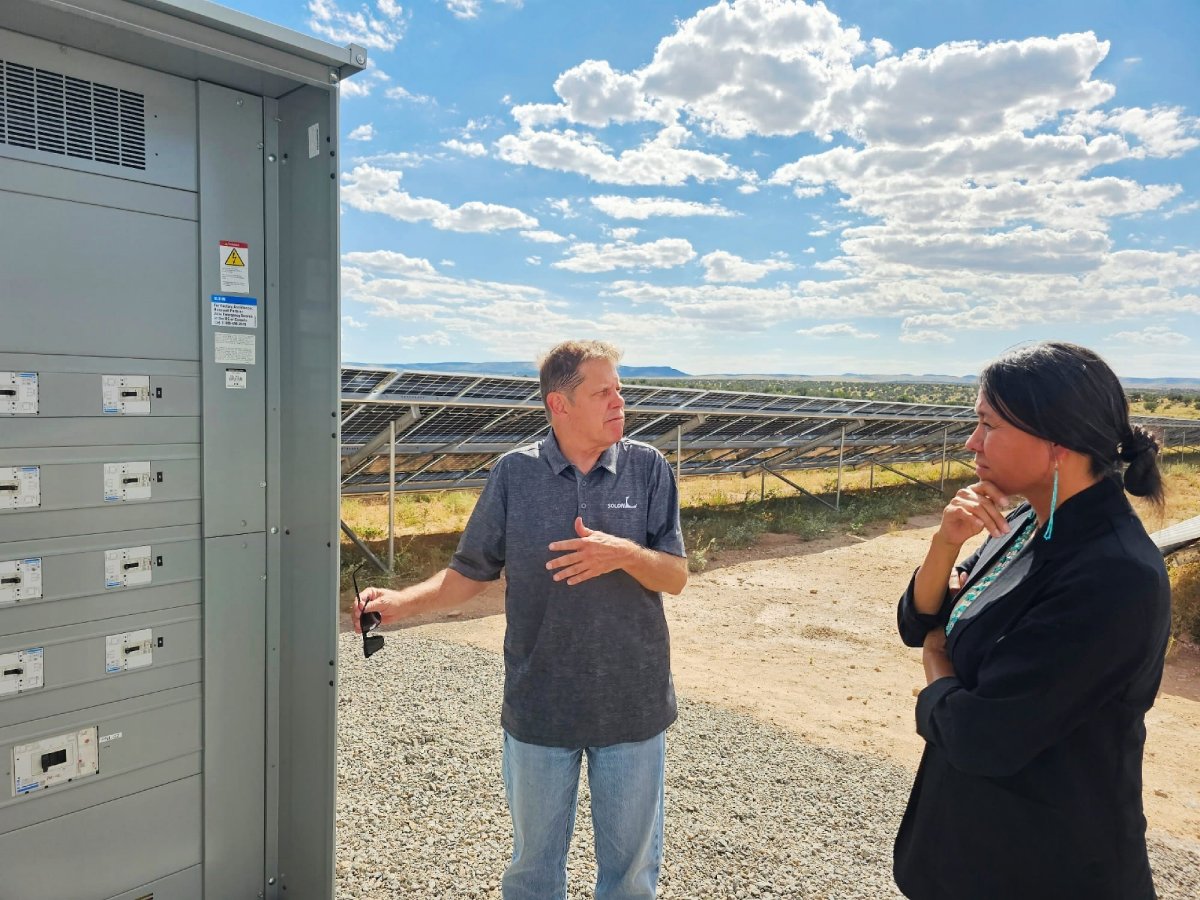Just as Indigenous communities are embracing a clean energy boom, one of the year's most acclaimed films has put a spotlight on the horrific toll that fossil fuel exploitation has taken on Native American communities.
Killers of the Flower Moon—director Martin Scorsese's latest epic, based on the nonfiction book by journalist David Grann—tells the true story of a criminal family's murderous theft from Native Americans, and oil lies at the dark heart of that story.
The Osage tribe had been forced from their original land onto a barren patch of Oklahoma that turned out to be sitting atop a major oil deposit. By the early 1900s, the Osage were fabulously rich and a tempting target for people who would kill to take the oil from them.
As Grann wrote, "The world's richest people per capita were becoming the world's most murdered."

The story Grann and Scorsese tell stands out for its extremes of wealth and violence. But in many ways, the story is typical of how energy resources were taken from native people throughout the 20th century, according to Torivio Fodder, who manages the Indigenous Governance Program at the University of Arizona.
In an interview with Newsweek, Fodder called the film "one snapshot of tragedy," and explained how unscrupulous business interests were often aided by the U.S. government. "There was an entire policy context that allowed those things to happen," he said.
Oil, coal and other resources drove exploitation of Indigenous land while much of the wealth that was generated flowed elsewhere.
"That is a story that you see across the plains, especially where you have all these enormous fossil resources and you have tribes that are impoverished," Chéri Smith told Newsweek.
Smith is president and CEO of the nonprofit Alliance for Tribal Clean Energy. In many cases, she said, even the energy generated by fossil fuels bypassed the people whose lands provided it. Fourteen percent of all Native Americans living on tribal land still do not have electricity, according to the Energy Information Administration.
"That means they don't have pumped water, they don't have refrigeration, they're running on diesel generators," Smith said. "This is in 2023."
Today, a new energy boom is underway with the rapid growth of renewable sources such as wind, solar and geothermal, all of which are abundant on tribal lands. Smith's group is working with tribal nations to make sure that this energy rush works for Indigenous people and not against them.
"It is an opportunity for the colonial, capitalist, patriarchal paradigm to shift," Smith said.
From Paternalism to Partnership
Killers of the Flower Moon is showing in theaters as many communities mark Native American Heritage Month in November, and Fodder said the film retells a painful but important part of the country's modern history. In the film, there's a recurring motif in which Osage woman Mollie Burkhart sits before a local official and states her name, an identification number and then a curious term: "Incompetent."
It's a striking thing to hear from a character played with obvious competence, intelligence and strength by Native American actress Lily Gladstone. Fodder explained that "incompetent" was the legal classification for the Osage and all Indigenous people.
"Indians weren't deemed to be competent under the goals of the General Allotment Act," he said. That 1887 law aimed to assimilate Native Americans into mainstream society by breaking reservation land into private allotments for individuals and families. Much of the income derived from many types of Indigenous land or other assets, such as the Osage oil rights, went into accounts managed by the federal government.
"Those funds were routinely mismanaged," Fodder said, and people receiving payment had no way to determine if it was fair. Deeper still, he said, the paternalistic nature of the law robbed Indigenous people of decision-making power.
"The whole notion of incompetence, that these people were not in a position to actually think for themselves or understand facts," he said. "That's just silly."
In 1996, a banker and tribal elder with the Blackfoot Confederacy, Elouise Cobell, filed a class action lawsuit charging the government with mismanagement of billions of dollars in oil, mining, grazing, timber rights and other royalties on native-owned lands. The litigation took more than a decade to resolve, and Fodder said the government is still working to correct the systems for valuing Indigenous resources and providing compensation.
Fodder grew up in Oklahoma and his ancestry connects him to the Comanche, Kiowa, Cherokee and Taos Pueblo people, so the Osage story hits close to home for him.
"This isn't far removed from my grandparents' generation and certainly my great- grandparents had lived through the whole allotment system," he said. Fodder said today he sees significant progress among government agencies and meaningful changes in leadership.
Interior Department Secretary Deb Haaland is a member of the Pueblo of Laguna and is the first Native American to serve as a cabinet secretary. The Interior Department oversees the Bureau of Indian Affairs, one of the most important agencies tribal governments deal with on a range of issues.
Fodder said the renewable energy boom is a chance for leaders like Haaland to change how tribes and the federal government work together.
"Here's an opportunity to say, 'Let's go from paternalistic to partnership,'" Fodder said.
Enormous Potential
Wahleah Johns directs the Department of Energy's Office of Indian Energy Policy and Programs, a job she came to with a deep and personal understanding of energy development on tribal land.
"I grew up two miles from a coal mining operation," Johns told Newsweek in an interview. That mine, located on Navajo and Hopi tribal land in Arizona, supplied a power station that sent electricity to Phoenix, Las Vegas and beyond.
"Yet over the hill from the mining operations, you have a lot of families that don't have access to power today," she said. "We still haul water. Our roads aren't paved."

Johns is a member of the Navajo, or Diné, tribe in Arizona where she co-founded the nonprofit Native Renewables to promote clean energy projects. She also worked with the citizens' group Black Mesa Water Coalition to address water pollution and depletion from coal mining.
Now with the DOE, she oversees an office that has guided $120 million in investments to 210 tribal energy projects over the past decade. This year, she said, the office announced an additional $72 million for tribal energy development, with most of that going to clean energy projects.
The Inflation Reduction Act (IRA), one of the Biden administration's key legislative achievements, provides a host of incentives for renewable energy development on tribal lands.
Tax credits have been a main form of government support for renewables, but tax-exempt groups like tribal governments were not able to take advantage of those. A key provision of the IRA converts the full value of a project's clean energy tax credits to direct payments instead.
"This is a game changer for tribes," Johns said.
Tribal leaders around the country are putting wind and solar to work for projects to power homes and businesses, provide back-up energy for critical facilities, generate revenue for their communities and enhance their energy independence.
Johns said a solar project at the Grand Canyon is a good example of renewable energy's potential. The Hualapai Tribal Authority secured a $2.4 million DOE grant to help build a solar microgrid to power its popular tourist facility, a lodge and "skywalk" above the canyon's edge.
The Grand Canyon West facility hosts nearly a million visitors a year but is not connected to the electric grid and previously relied on diesel generators for power. The solar and battery storage installation is expected to pay for itself in three to five years by reducing diesel fuel costs.
But even with the new incentives, renewable energy developments take lots of work and money. Tribes must still navigate government policy, find matching money for grants and, in many cases, negotiate tricky land use disputes and electrical grid connections.
That's where Smith's Alliance for Tribal Clean Energy comes in. Smith is a descendant of the Mi'kmaq Nation of Northern Maine and the Canadian Maritimes, and her group works with tribes on financing, technical assistance and worker training so as to take full advantage of federal incentives.
She said tribes hold approximately five percent of the country's land and thus have enormous potential for clean energy development. The Alliance is working with more than 50 tribes on projects that hold the promise of four gigawatts of clean energy.
"We're just trying to make hay while the sun shines," she said.
Time will tell whether the clean energy work underway can help undo some of the damage done from the past pursuit of dirty energy on Indigenous lands.
In his book, David Grann quotes an Osage chief interviewed in the 1920s who talked about the costs that came with oil wealth.
"Someday this oil will go and there will be no more fat checks every few months," the chief said. "Then I know my people will be happier."
About the writer
To read how Newsweek uses AI as a newsroom tool, Click here.



